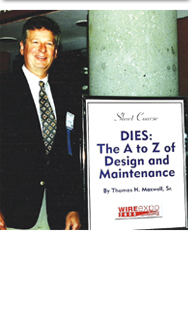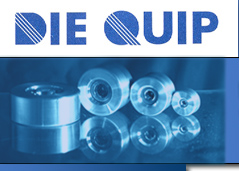


 |
White Papers
| |
Meeting Points
vs. Bumping
|
| |
There are two different methods for producing wire-drawing dies. The first method is the meeting point while the other is bumping. Each has its advantages and drawbacks, which should be evaluated to make sure dies are produced to the highest quality with the least amount of time. This paper is intended to discuss both methods to help in the decision of which is best suited for each application.
|
| |
Cost per Ton
compared to Cost
per Die
|
| |
In most drawing factories the only analyzing of die cost is the actual purchase cost, die shop overhead, how many dies are made per operator or how fast the die can be re-worked. The real value the die holds is in the mills overall production efficiency and should be looked at in production not purchase cost or overhead terms. Simply put the more die changes, scrap and customer returns the less efficient the die shop or supplier is. This paper is intended to layout how dies should be analyzed, what effect the die has on production, problems with focusing on low cost die production and cost analysis of the dies in production.
|
| |
Die Measuring
Technology Overview
|
| |
The die is the heart of any drawing operation and one of the most important factors in generating the wire or tube quality. It is one of the few items that can be inspected quickly to determine if it is causing a drawing problem. The die consists of two internal forms, conical angle and cylindrical bearing, that are very difficult to measure in diameters under .035” (0.9mm). The purpose of this paper is to cover the different inspection systems, techniques for measuring the different characteristics of the die, reality in getting accurate measurements and following inspection standards to ensure measurement results.
|
| |
Coiled Bar Design
|
| |
Traditional die
designs can cause
many problems in
drawing larger diameter
wire. Current carbide
nibs do not provide
enough height to
allow the use of
proper drawing angles
for most reductions
taken on larger
material, which,
leads to poor material
deformation, surface
defects and customer
rejects during forming.
This paper is intended
to suggest solutions
to the current deficiencies,
suggest practical
solutions to existing
dies and how to
better design dies
to draw larger diameter
wire. |
| |
Why Choose Die
Quip
|
| |
Die Quip was
founded as an equipment
builder to make
finishing dies faster
and easier for an
in-house die shop.
All of our equipment
is designed using
sound machine designs,
time tested work
holding methods
and built on a rigid
platform to consistently
make heavy cuts.
We are not a die
shop that designed
equipment for internal
use for production
of new dies. This
makes our philosophy
in building tungsten
carbide draw die
working equipment
different than our
competition. We
have the widest
diameter working
range of any company
in the industry
and have products
for the wire, bar
and tube drawing
industries.
Click Here to read
more
|

|




